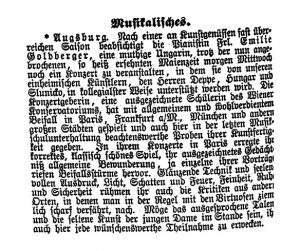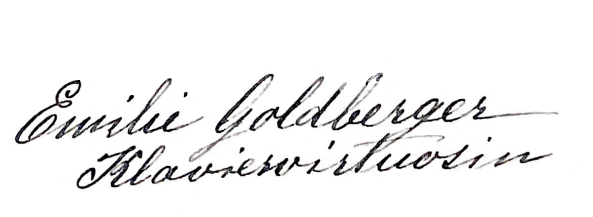About Emilie Goldberger

“Emilie Goldberger: my piano teacher, a former pupil of Anton Rubinstein, a very small, fragile, elderly lady” – as told by Emile Zuckerkandl (1922-2013), grandson of the great Viennese salonière Berta Zuckerkandl (1864–1945). So far, this is the only description of what Emilie Goldberger might have looked like. More is not known at the present time (August 2023). And this can’t be the case yet: For years I have been dealing with historical Augsburg newspapers, and not only with music history – while reading one of these newspapers in February 2023 my eyes got stuck on a concert report in which the name Emilie Goldberger appeared.
I googled. The very first hit was a historical document. A death certificate from the Theresienstadt Ghetto, with a birth date: November 17, 1858 – the same year as the great composer Ethel Smyth (d. 1944). With a death date: September 20, 1942. Emilie Goldberger was 83 years old when – as I found out through initial research – she and many others were mercilessly taken from the Seegasse Jewish Home for the Elderly in Vienna, locked into a cattle car at the Aspang railway station, and sent on the long journey to the Theresienstadt ghetto.
83 years. What might she have experienced? Through meticulous research, I have discovered some famous names in music history that played a role in Emilie Goldberger’s life. Not only those of Anton Rubinstein (1829–1894), Anton Door (1833–1919), Anna von Suppè (1876–1923) or Berta Haft (1857–1931), but also those of Clara Schumann (1819–1896). Emilie Goldberger was one of her students in her very first year at Dr. Hoch’s Conservatory in Frankfurt am Main. It is not every day that one discovers a Clara Schumann student!
I was thrilled and within three days had searched not only all Austrian newspapers for Emilie Goldberger, but also other European newspapers, so that Emilie Goldberger’s concert and teaching activities as well as her repertoire and showpieces gradually emerged. During her four years on tour, she also lived, played and taught in Paris. Another clue may reveal that she was a composition student of Johannes Brahms (1833–1897).
Now I had a framework to be able to trace her life to some extent. So far nothing has survived from Emilie Goldberger except a handwritten letter, which Sabine Falke (formerly piano manufactury Ibach) kindly provided me with as a scan. After Emilie Goldberger’s deportation to the Theresienstadt Ghetto, the Nazi authorities had her apartment and property cleared. The fact that there might have been an original manuscript of a song by Franz Liszt (1811–1886, see repertoire) in there, which is now mysteriously considered lost: Remarkable!

You see: The small concert news from Augsburg developed almost explosively into a big story. By means of a timeline, I will try to tell you the story of Emilie Goldberger, which is still very incomplete – that’s all I have yet. I would have to research further in Vienna, Paris, Theresienstadt Ghetto and other places where she lived or summered. Since she also offered piano lessons almost everywhere, perhaps her students:inside could become accessible again in this way. Perhaps there are still records of Emilie Goldberger. I could not find a photograph yet. But it would be nice if Emilie Goldberger could get a ‘face’ again. She lived unmarried, earned her own money and could therefore travel and pursue her music as independently as possible.
First, I created an 11-page leporello with the stations of Emilie Goldberger’s life and work from my collection of material. This is the basis for the timeline on this web presence, in the hope that perhaps someone who knows more about Emilie Goldberger will become aware of her. In Frankfurt am Main, they could not answer my questions at the Jewish Museum. The Archive of Women in Music in the same city was also at a loss. Corresponding inquiries in Vienna have so far remained unanswered.
Due to other projects and commitments, I had to put the Goldberger project on hold for the time being, but I often thought about it. My collection of material alone was beyond the scope of a normal blog post on my website. That’s why I had to come up with a different concept, especially to better present the timeline. This one is long, but if you search for specific names, you can find everything on a single page. As long as the research is not finished, a website like this works as a documentation.
Scientific papers and publications about Emilie Goldberger are in preparation in German and English, and I had to put that on hold, too, for the time being. From this, encyclopedia and online encyclopedia entries can be created for even wider dissemination. In these publications you will find all the individual references to what has been told in this website project, as well as further astonishing facts and cross-references to hitherto unknown family constellations, kinship references and life data, especially to the violinist Bertha Haft.
If you would like to help me find more pieces of the puzzle of Emilie Goldberger’s life or if you would like to know more about her, please write to me! I am currently doing all this in my spare time.
